Congress
-
- Changes In The Navy Shipbuilding Program — An Update — Maritime Reporter, Nov 15, 1983 #16
International Maritime Associates, Inc., is a management consulting firm located in Washington, DC. The firm specializes in providing market analyses, competitive assessments, project evaluations and corporate planning. Recent clients include M.A.N.-B&W Diesel, Grumman Aerospace, Todd Shipyards, World Bank, Industrial Development Bank of Malaysia, and various Scandinavian shipowners. IMA has been involved in maritime projects in more than 15 countries. For additional information, contact James R. McCaul, International Maritime Associates, Inc., 1800 K St. N.W., Washington, D.C. 20006.
Telephone (202) 296-4615 or telex 64325.
This update is divided into three sections: legislative action, developments in the shipbuilding program, and Navy contracts awarded since June. It includes information available as of September 30,1983.
1. L E G I S L A T I V E ACTION Fiscal Year 1984 Defense Authorizations Passed, Appropriations Still in Committees FY 1984 Defense Authorization has passed in both House and Senate.
A House-Senate Conference Report (98-213) was issued August 16.
Final passage in Senate came on September 13. Final vote in House was taken on September 15. President Reagan signed the bill into law on September 24.
Appropriations bills are in committee mark-up process. A Continuing Resolution will provide defense funding until November 15 at FY 1983 levels. This action will allow further time for passage of FY 1984 Appropriations. Another Continuing Resolution will be necessary, should Congress be unable to meet the November 15 deadline.
Congress trimmed Navy budget request by almost 5 percent, reflecting across-the-board cuts imposed by the First Concurrent Budget Resolution.
Exhibit I presents a breakdown of the requested versus authorized levels of Navy spending.
Impact on Navy Shipbuilding Program Congress has authorized new construction of 16 ships, conversion of five others, and acquisition of one from the British Navy in FY 1984.
This program differs from the Administration request by: • eliminating construction of one fleet oiler (TAO) • reducing the number of mine counter measures ships (MCM) from four to three • adding one guided missile frigate (FFG) Exhibit 2 compares the final Congressional authorization for Navy shipbuilding with the Administration's request.
CG-47—Aegis Guided Missile Cruiser Construction of three CG-47's has been authorized. This action brings to 12 the number of CG- 47's authorized, with another 11 scheduled for FY 1985-88. A total of 27 CG-47's are planned.
DDG-51—Arleigh Burke Class Guided Missile Destroyer The DDG-51 program has drawn considerable Congressional attention.
Issues involve estimated cost of each ship ($700 million to in excess of $1 billion), growth margins for future equipment, capabilities of the design, and requirements to be met by the ships. Specific questions have arisen over the lack of LAMPS III ASW helicopter facilities and inability to install Rankine Closed Energy Recovery (RACER) System in the first eight ships. Congress has requested a report from Navy addressing these issues and questions by November 1983.
FFG-7—Guided Missile Frigate Congress added an FFG-7 class ship to the Navy program. This action was taken because: • it was felt the ship could be acquired relatively cheaply since the class is already in series production • the additional ship would help preserve jobs in the shipbuiling sector Congress reversed the Administration, stating that Navy has a validated requirement for more FFG-7's. Congress pointed to the distribution of recent Navy contracts (and lack of new commercial orders), stating this situation threatens to increase unemployment in shipbuilding.
LHD-1—Amphibious Assault Ship Congress authorized the $1.4 billion requested for this modified version of the LHA design. Contract will be awarded to Ingalls on a sole source basis.
LPD (SLEP) Authorization for advance procurement funding of this program was denied. Navy planning has moved this program back by one year. Advance procurement funding will now be requested for FY 1985. The first actual SLEP is now scheduled to begin in FY 1986.
LSD-41—Landing Ship Dock Multiyear procurement of five ships over the next three years has been authorized. The Senate initially rejected multiyear procurement on grounds that budget constraints would prohibit full funding of the planned procurement.
However, cost savings attributed to the multiyear program convinced the conference committee of the advantages of acquiring the ships under multiyear contracting.
CV (SLEP) Advance procurement funding for the FY 1985 SLEP of U.S.S.
INDEPENDENCE was authorized in full.
BB—Battleship (Reactivation) Advance procurement funding for reactivation of U.S.S. MISSOURI was authorized in full.
The currently active battleship, U.S.S. NEW JERSEY has demonstrated a wide range of capabilities achievable through reactivation and modernization. However, questions have been raised with regard to the ship's role to support amphibious operations versus use as a strategic cruise missile platform.
While continuing to support the program, Congress has requested a better definition of the role the BB will play in the fleet.
SSBN—Trident Ballistic Missile Submarine Authorization for construction of one OHIO class submarine was approved. Revised cost estimates submitted by Navy indicated that savings of $73 million could be expected in this program. Congress reduced the authorized amount to reflect these savings. The ship is to be configured to carry the D-5 version of the Trident Missile.
SSN-688—Nuclear Attack Submarine Three SSN's have been authorized for FY 1984. Advance procurement of $336 million has been authorized for later ships.
MCM-I—Mine Countermeasures Ship Three MCM's were authorized for FY 1984, a reduction of one from Navy's request.
The MCM design has experienced weight problems due to need for nonmagnetic, highly shock resistant equipment. MCM-I's hull design has been lengthened to accommodate increased weight. Also, Navy has reopened competitive procurement of diesel engines for the ship's propulsion.
TAO—Fleet Oiler Authorization of $365.4 million eliminated one of the three ships requested by Navy. The reduction was made due to budget constraints.
No significant problems have developed in the construction program.
LCAC—Landing Craft Air Cushion $131.6 million was authorized for procurement of six LCAC's.
Another $29.5 million was authorized for advance procurement.
Strategic Sealift $31 million was authorized for purchase of U.S. flag ships from the commercial fleet for use in the Ready Reserve Fleet. Notice of proposed purchases under this authorization are subject to Navy's notification of Congress before a 30-day continuous session of Congress.
Restrictions Placed on Long- Term Leases for Ships The MSC's Build/Convert and Charter Program came under detailed scrutiny in Congress last Spring. The T-AKX and T-5 tanker programs, totalling ten new constructions and eight conversions, have been the focus of concern over the use of operation and maintenance funds for acquisition of ships. As a result Congress established the following guidelines for future programs of this nature: (1) Whenever a request is submitted to Congress for the authorization of the lease of an aircraft or naval vessel, the Secretary of Defense shall submit with that request an analysis of the cost to the United States (including lost tax revenues) of any such lease arrangement compared with the cost to the United States of direct procurement of the aircraft or naval vessel by the United States.
Any such analysis shall be reviewed and evaluated by the Director of the Office of Management and Budget and the Secretary of the Treasury within 30 days after the date on which the request and analysis are submitted to Congress.
The Director and Secretary shall conduct such review and evaluation on the basis of the guidelines issued pursuant to this Act and shall report to the Congress in writing on the results of their review and evaluation at the earliest practicable date, but in no event more than 45 days after the date on which the request and analysis are submitted to the Congress.
(2) Whenever a request is submitted to Congress for the authorization for funds for the Department of Defense for the long-term lease of aircraft or naval vessels authorized under this section, the Secretary of Defense—(A) shall indicate in the request what portion of the requested funds is attributable to capital-hire; and (B) shall reflect such portion in the appropriate procurement account in the request.
(3) The Director of the Office of Management and Budget and the Secretary of the Treasury shall issue jointly guidelines for determining under what circumstances the Department of Defense may use lease arrangements for aircraft and naval vessels rather than directly procuring such aircraft and vessels.
(4) Funds appropriated pursuant to an authorization contained in this Act may not be used to indemnify any person under the terms of a contract entered into with the United States for a lease that is authorized under this section—(A) for any amount paid or due by any person to the United States for any liability arising under the internal Revenue Code of 1954; or (B) to pay any attorney fees in connection with such contract.
(5) At the same time that the President submits the budget request for the Department of Defense to Congress for fiscal year 1985, the Secretary of Defense shall submit a written report to the Committees on Armed Services and on Appropriations of the Senate and House of Representatives concerning leases.
(6) During fiscal year 1984 obligation of funds for a lease authorized under this section that includes a termination liability in excess of 50 percent of the original purchase value of the vessel, aircraft or vehicle is prohibited unless Congress has specifically provided budget authority for the obligation of 10 percent of such termination liability.
(7) Nothing in this section shall impede or affect the ability of the Secretary of the Navy to proceed to acquire the use of thirteen TAKX class Maritime Prepositioning Ships and the use of five new T-5 tankers in accordance with the long term charter arrangements negotiated by the Navy before the date of enactment of this Act.
The conferees direct the Secretary of Defense to promptly report to the Committees on Armed Services of the Senate and House of Representatives any contract to lease of such contract: (A) is entered into between June 14, 1983, and the effective date of this section; and (B) would provide for indemnification of Federal tax liability of any person or would provide for indemnification of attorney's fees.
In effect, Congress permitted the Navy to proceed with the TAKX and T-5 contracts. But Navy was told not to do it again—withour prior Congressional approval.
1985 Defense Spending Program Defense Program Decision Memoranda (PDM) issued August 22 mark the end of the POM process.
These memoranda state the Deputy Secretary of Defense decision on size and composition of program funding for FY 1985.
As a result of the DoD review process, Navy is required to restructure $800 million of planned spending in 1985. This action was imposed by the Deputy Secretary of Defense to reflect more realistic cost estimates and inflation adjustments.
Navy is instructed to start preliminary alternative designs of a new nuclear attack submarine.
Several small ship programs proposed by Navy for FY 1985 have been deleted or deferred. Navy is ordered to deploy a fourth aircraft carrier abroad, reflecting the continued importance of the carrier task force in Navy planning. In recent past, Navy has had three carriers deployed—one each in the Pacific, Mediterranean and Indian Ocean.
These actions are forming the basis for the budget submission to Congress next January. Congress, of course, can impose changes.
2. DEVELOPMENTS IN SHIPBUILDING PROGRAMS Since June, the hospital ship (TAH) has been contracted, several program changes have been announced, and four new programs have surfaced.
T-AH—Hospital Ship (Conversion) NAVSEA awarded initial contract for the T-AH to NASSCO in late June. The $186 million contract calls for conversion of a San Clemente design tanker. NASSCO has chosen 92,000 DWT tanker, ROSE CITY, delivered in 1976, for conversion. Subcontracting is now underway. Delivery is scheduled for October 1986.
NASSCO's contract includes option for second conversion to be exercised in January 1984. Congress has authorized $260 million for the second conversion, but funds are not yet appropriated.
MSH—Mine Sweeper Hunter This program has advanced through the first competitive design phase. Initial designs were submitted by four shipyards on August 15. The second round of competitive design will begin with award of detailed design contracts to two shipyards this fall.
Congress has authorized, but not yet funded, MSH lead ship award in FY 1984.
DDG-51—Arleigh Burke Class Guided Missile Destroyer Head of PMS 400, the office responsible for the CG-47 and DDG- 51 programs, is now RAdm. D.
Roane. He recently replaced RAdm. Wayne Meyer, who moved to NAVSEA 06 as Deputy Commander, Combat Systems Directorate.
The DDG-51 is currently in contract design stage. NAVSEA has organized a design team which includes numerous firms performing naval architecture, program support and systems design/modification.
The three shipyards participating in this design effort are Bath, Ingalls, and Todd-L.A.
Award of lead ship contract is scheduled for early FY 1985. The RFP for lead ship contract is scheduled for release in Spring 1984. Construction awards scheduled for the first 29 ships through 1992 is shown in Table I.
DDG-51 design incorporates machinery, weapons, and a combat system similar to the CG-47 class cruiser. These systems are to be improved through design modifications.
Phased introduction of upgraded systems into DDG-51 is scheduled for each of three flights over the next eight years.
Several major system upgrades are currently in design stage. They will also be incorporated into later ships of the CG-47 Aegis cruiser class. Upgrade 1, to be installed on the first flight of DDG-51 and the CG-62, includes a new digital control system and high power density reduction gear: • design of the digital control system is being handled by Bath.
An RFP for procurement of the system is due in January 1984, with contract award scheduled for August 1984 • the RFP for the new high power density reduction gear was released September 2. Bids are due October 14 with contract award scheduled for Spring 1984 4The second flight of DDG-51 construction will incorporate further equipment upgrades. Included will be: • the Rankine Closed Energy Recovery (RACER) System • a new 18 foot controllablepitch propeller Procurement schedules for these items have not yet been finalized.
Other DDG-51 program developments include: • Sperry was recently selected as contractor for the AN/UYK-43 computer system for the ship • Navy is currently developing a second source for the Vertical Launch System. FMC Northern Ordnance Division is likely to receive a directed second source contract for this system Other Potential Shipbuilding Programs Have Surfaced Naval Gunfire Support Ship Congress authorized $500,000, requesting Navy to investigate the potential of a Naval Gunfire Support Ship. This request grows out of concern that the trend towards missile armament on Navy ships has reduced Navy's capability in a critical amphibious support role.
Nuclear Attack Submarine Navy will request funding in FY 1985 for design of new attack submarine (SSN). To incorporate new developments in hull strengthening, silencing, and underwater speed, new design may be ready for construction award in late 1980's.
Amphibious Cargo Dock—LKDX Prefeasibility studies are being conducted on a concept design for a modified LSD-41. Top Level Requirement (TLR) is not yet formulated and no firm program is yet established. This concept may be substituted for the planned LPDX Program.
Army Amphibious Vessels and Craft Army has developed plans to acquire several types of amphibious craft and support vessels, using existing designs modified to meet the purchase specifications: • Landing Craft Utility (LCU)— up to 50 of these 130+ ft. craft may be procured; several designs are being considered, including foreign designs from the Netherlands (Damen) and the U.K.
(Rotork) • Logistics Support Vessel (LSV)—four of these small ships (300 ft.) are to be procured over the next four years. The LSV is to be a diesel powered, twin or triple screw vessel designed to carry a minimum of 2,000 short tons of cargo. It will have bow and stern ramps. Range must be 5,500 miles and a minimum speed of 12 knots is specified • other craft include 20 large tugs, 20 small tugs, and 20 crew/' patrol boats Initial contract awards are scheduled for FY 1984.
3. CONTRACTS Since June 1983, Navy has awarded over 200 major contracts with a total value exceeding $5.8 billion. Twelve major U.S. defense contractors have received more than 75 percent of the value of these awards: • Litton • McDonnell Douglas • Lockheed • United Technologies • Westinghouse Electric • Grumman • Hughes Aircraft • Raytheon • IBM • General Electric • General Dynamics • Morrison-Knudsen Exhibit 3 lists major Navy contracts awarded between June 1 and September 30 as announced by the Department of Defense and published in the Wall Street Journal.
The list is not comprehensive, but has been arranged to include contracts for ships, systems, weapons, and services. Aircraft-related contracts are not included.
EDITOR'S NOTE: Since the mid-1960's, 100% of all new U.S. Navy vessels (and some for Allies) have been constructed in privately owned shipyards (the prime contractors).
About 30- to 35% of Navy repair and overhaul work is also accomplished in civilian yards. The Naval Shipyards perform no new construction work.
Almost all, if not all, of the nation's leading naval architectural firms (private corporations) have been engaged, to a great degree, in naval work for decades. Most of the individuals (civilians) in both the shipbuilding and design areas who have been responsible for the selection and purchase of equipment and services for private shipbuilding projects are the same private individuals now responsible where naval work is concerned.
There is a clear and important distinction, between what is known as GFE (government- furnished equipment) and CFE (contractor-furnished equipment). When the Navy awards a contract to a private shipbuilder (the prime contractor) for construction of, say, a nuclear-powered aircraft carrier it will normally specify in detail what systems, subsystems, and equipment items will be built or purchased by the prime contractor (the private yard) (CFE) and what will be built or purchased by the government and provided to the prime contractor (GFE).
The shipyard, as prime contractor, has the authority to choose one supplier over another where contractor furnished equipment (CFE) is concerned.
For example, the total contract price for the two carriers, CVN 72 and 73, is approximately $6.7 billion.
Government Furnished Equipment (GFE) is not included in this figure.
Of the $6.7 billion, approximately $2.2 billion will be used for normal shipyard operating expenses such as salaries, etc. Therefore, the shipyard, a private company staffed and managed by civilians, has the discretionary authority to spend in the neighborhood of about $4.5 billion with sub-contractors and suppliers—about twothirds of the money.
The dominant role played by commercial shipyards and civilian personnel in the construction of Naval vessels and the selection and purchase of equipment cannot be overemphasized.
-
- Maritime Challenges: A Time to Act Boldly Marine News, Feb 2019 #20
Maritime Challenges in the 116th Congress.The 116th Congress, with its now Democrat-controlled House and 110 newly-elected members, faces a choice. On one hand, Congress can continue to pursue the status quo, supporting U.S.-flag vessel operators and domestic port infrastructure development through existing
-
- NEW NAVY BUDGET: OVER $100 BILLION Maritime Reporter, Mar 1986 #22
"conventional" (non-nuclear) as opposed to a "strategic" (nuclear) conflict. Projection tables, trend statistics, and other supporting data provided Congress by Secretary of Defense Caspar Weinberger in his February 5 "Annual Report to the Congress" also show the following: • The Department of Defense's fiv
-
- SUCCESS O N TAX FRONT DOMINATED 100TH CONGRESS Maritime Reporter, Mar 1989 #47
of the association's goals for 1989 is to increase its visibility and effectiveness on issues within the jurisdiction of the taxwriting committees of Congress— the House Ways and Means Committee and the Senate Finance Committee. AWO will be closely monitoring deficit reduction proposals in all forums
-
- 15th International Congress On Combustion Engines Set For Paris, June 13-17 Maritime Reporter, Apr 1983 #16
The 15th International Congress on Combustion Engines (CIMAC) will be held at the Palais des Congres in Paris, France, from June 13 to 17, 1983. The first session of the CIMAC congress will be held the morning of June 13 and will feature an address by Mr. Balaceanu, director general of the French
-
- Water Resources Congress Reports Annual Meeting Maritime Reporter, Apr 1980 #61
At its recent annual meeting held in New Orleans, La., the Water Resources Congress elected Maurice C. Stout, vice president, Indianapolis Water Company, Indianapolis, Ind., chairman of the board; Tval Goslin, consultant, Western Engineers, Inc., Grand Junction, Colo., vice chairman; B. Joseph
-
- 1980 Annual Meeting, Water Resources Congress Maritime Reporter, Jan 15, 1980 #12
New Orleans, La., was selected as the site of the 1980 annual meeting of the Water Resources Congress to be held February 13- 16, at the New Orleans Hilton Hotel. This year's convention promises to be particularly significant and enjoyable for numerous reasons. It is being held during the week of the
-
- CIMAC Congress Set for Kyoto Maritime Reporter, May 2004 #29
One of the world's premier technical events leading the discussion of combustion engine technology across the industrial board is the CIMAC World Congress, which is set to convene at its 24th event in Kyoto, Japan, from June 7 to 11. The CIMAC Congress - founded in 1951 and is the French acronym
-
- Navy Delivers Strategic Sealift Plan To Congress Maritime Reporter, Nov 1991 #129
The Navy recently delivered to Congress a long-awaited plan on how the Service intends to conduct its sealift program. The Navy's strategic sealift implementation plan said it "would lead to a shipbuilding or major conversion program" with "its size, scope and mix determined by the MRS (mobility
-
- John Cassedy Urges Congress To Stem Tide Of Soaring Liability Awards To Seamen Maritime Reporter, Dec 1978 #58
Calling upon Congress to enact a "good and fair" Seamen's Compensation Act in 1979 to help stem the tide of soaring liability awards to seamen, John H. Cassedy, president of the Shipowners Claims Bureau and secretary of the American Club (The American Steamship Owners Mutual Protection & Indemnity
-
- Congress Eyes Maritime Economic Relief Marine News, Sep 2020 #20
, in addition to a $25 billion worker support program that provides a mix of grants and loans to cover employee wages, salaries and benefits. In addition, Congress waived the small business affiliation rules for businesses in the accommodation and food service industries to increase the availability of Paycheck
-
- Congress Provides Last-minute Help for Small Inland and Coastal Ports Marine News, Mar 2021 #15
In two major pieces of legislation passed by Congress at the end of 2020 and the beginning of this year, Congress addressed the difficulty that many smaller inland and coastal ports have in obtaining funding for their infrastructure projects. First, on December 11, 2020 Congress passed the William M. (Mac)
-
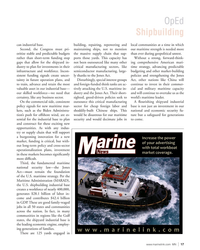 )
April 2024 - Marine News page: 17
)
April 2024 - Marine News page: 17OpEd Shipbuilding can industrial base. building, repairing, repowering and local communities at a time in which Second, the Congress must pri- maintaining ships, not to mention our maritime strength is needed more oritize stable and predictable budgets the massive supply chain that sup- than ever
-
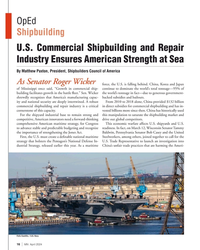 )
April 2024 - Marine News page: 16
)
April 2024 - Marine News page: 16market and competitive, American innovators need a forward-thinking drive out global competitors. comprehensive American maritime strategy, for Congress This economic warfare affects U.S. shipyards and U.S. to advance stable and predictable budgeting and recognize readiness. In fact, on March 12
-
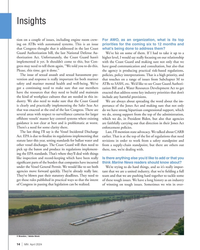 )
April 2024 - Marine News page: 14
)
April 2024 - Marine News page: 14For AWO, as an organization, what is its top ing on ATBs with automated systems. This is an issue priorities for the coming six to 12 months and that Congress thought that it addressed in the last Coast what’s being done to address them? Guard Authorization bill, the last National Defense Au- We’ve hit
-
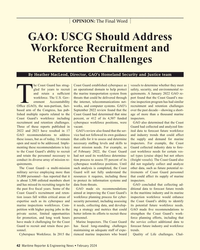 )
February 2024 - Maritime Reporter and Engineering News page: 42
)
February 2024 - Maritime Reporter and Engineering News page: 42program has had similar Of? ce (GAO), the non-partisan, fact- works, and computer systems. GAO’s recruitment and retention challenges based arm of the Congress, has pub- September 2022 review found that the over the past decade—showing a short- lished multiple reports related to the Coast Guard had determined
-
 )
February 2024 - Marine News page: 23
)
February 2024 - Marine News page: 23to another. tions within the next 30 days.” A copy of the letter was After all, passengers aboard a cruise ship in the Caribbean sent to 10 members of Congress. Homendy notes that, in fact, the USCG did issue an face safety issues that are much different than a commuter going from Jersey City to Manhattan
-
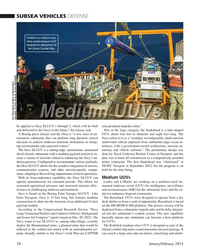 )
January 2024 - Marine Technology Reporter page: 28
)
January 2024 - Marine Technology Reporter page: 28shelter or from a craft of opportunity. Razorback is based payload module. on the HII REMUS 600 platform. The newest version will be According to the Congressional Research Service “Navy deployed from a submarine torpedo tube and be fully integrat- Large Unmanned Surface and Undersea Vehicles: Background
-
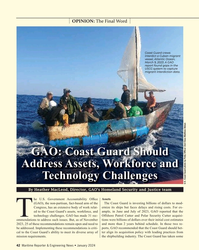 )
January 2024 - Maritime Reporter and Engineering News page: 42
)
January 2024 - Maritime Reporter and Engineering News page: 42U.S. Government Accountability Of? ce Assets (GAO), the non-partisan, fact-based arm of the The Coast Guard is investing billions of dollars to mod- Congress, has an extensive body of work relat- ernize its ships but faces delays and rising costs. For ex- ed to the Coast Guard’s assets, workforce, and
-
 )
November 2023 - Marine News page: 44
)
November 2023 - Marine News page: 44would be inoperable, spelling “long- the business case from Volpe, allowed MARAD to receive term negative impact on national security, reducing the Congressional funding to begin the NSMV program in number of credentialed mariners available to operate U.S. earnest. However, Congress saw the value of
-
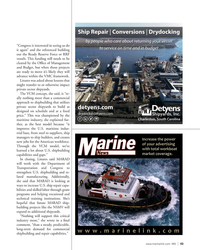 )
November 2023 - Marine News page: 43
)
November 2023 - Marine News page: 43“Congress is interested in seeing us do it again” and she referenced building out the Ready Reserve Force or RRF vessels. This funding still needs to be cleared by the Of? ce of Management and Budget, but when those projects are ready to move it’s likely they will advance within the VMC framework.
-
 )
November 2023 - Marine News page: 39
)
November 2023 - Marine News page: 39comments focused on a new business model. More speci? cally, a Vessel Construction Manager (VCM) contract model, a programmatic requirement set by Congress in the 2017 National Defense Authorization Act, directing MARAD to “provide for an entity other than the Maritime Administration to contract for
-
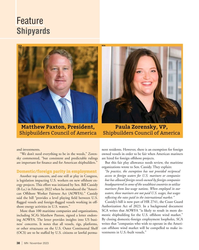 )
November 2023 - Marine News page: 38
)
November 2023 - Marine News page: 38reciprocal Domestic/foreign parity in employment access to foreign waters for U.S. mariners or companies Another top concern, and one still at play in Congress, but has allowed foreign vessels owned by foreign companies is legislation impacting U.S. workers on new offshore en- headquartered in some of the
-
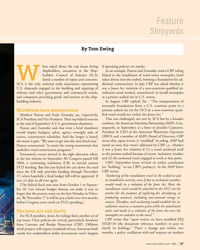 )
November 2023 - Marine News page: 37
)
November 2023 - Marine News page: 37.” Fortunately, events moved in the right direction when, to the pristine seabed because of severe, inclement weather at the last minute on September 30, Congress passed HB and (2) the anchored vessel engaged in work at that point. CBP’s September letter revised its earlier conclusion 5860, a continuing resolution
-
 )
November 2023 - Marine News page: 18
)
November 2023 - Marine News page: 18has shown that the continued and regu- of zero-emission technologies in the heavy-duty vehicle and lar authorization and appropriation of funds by Congress for port sectors in the agency’s development of funding pro- such programs cannot be relied on, with recent developments grams under the Infation
-
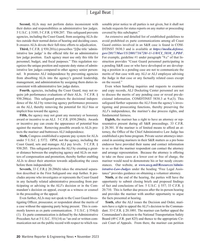 )
November 2023 - Maritime Reporter and Engineering News page: 20
)
November 2023 - Maritime Reporter and Engineering News page: 20means to afford an at- tects the mariner and buttresses ALJ independence. torney, the Of? ce of the Chief Administrative Law Judge has Sixth, Congress established a separate pay system for ALJs established a pro bono program. Private sector attorneys inter- under 5 U.S.C. § 5372. OPM, not the agency
-
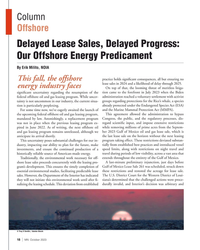 )
October 2023 - Marine News page: 18
)
October 2023 - Marine News page: 18federal offshore oil and gas leasing program, This agreement allowed the administration to bypass mandated by law. Astonishingly, a replacement program Congress, the public, and the regulatory processes, dis- was not in place when the previous leasing program ex- regard scienti? c input, and impose extensive
-
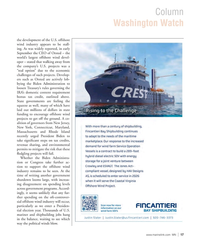 )
October 2023 - Marine News page: 17
)
October 2023 - Marine News page: 17, revenue sharing, and environmental permits to mitigate the risk that these ? edgling projects will fail. Whether the Biden Administra- tion or Congress take further ac- tion to support the offshore wind industry remains to be seen. At the time of writing another government shutdown looms large
-
 )
September 2023 - Maritime Reporter and Engineering News page: 27
)
September 2023 - Maritime Reporter and Engineering News page: 27MarAd has been very supportive with funding training,” gressional funding to begin the NSMV program in earnest. from the power to the bridge. However, Congress saw the value of partnering with private In addition, the SUNY team has been in Philadelphia at the industry to ef? ciently construct these next
-
 )
September 2023 - Maritime Reporter and Engineering News page: 18
)
September 2023 - Maritime Reporter and Engineering News page: 18operators of U.S.-? agged I sault aboard a U.S.-? agged ship during her Sea Year training vessels and identify several as-yet unresolved issues. — Congress enacted into law the Safer Seas Act (SSA) in De- cember 2022. Intended as a direct effort to prevent and punish What types of misconduct must be
-
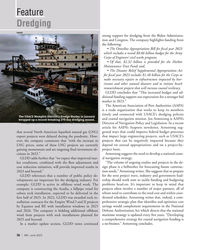 )
June 2023 - Marine News page: 36
)
June 2023 - Marine News page: 36Feature Dredging USACE strong support for dredging from the Biden Administra- tion and Congress. The company highlights funding from the following: • The Omnibus Appropriations Bill for ? scal year 2023 which includes a record $8.66 billion budget for the Army Corps of Engineers’ civil works program; •
-
 )
June 2023 - Marine News page: 11
)
June 2023 - Marine News page: 11economic domi- nance, and we have to continue to support it,” he said. “We have come together and recognize the need—not just the industry, but Congress as well—to better fund [river infra- structure]. . . We have funded our infrastructure to be able to repair and operate locks and dams very well
-
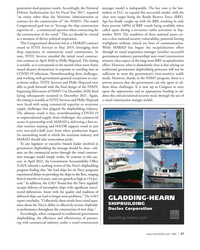 )
August 2023 - Marine News page: 17
)
August 2023 - Marine News page: 17being the Ready Reserve Force (RRF). contract for the construction of” the NSMVs. The stated Age has ? nally caught up with the RRF, resulting in only Congressional goal was to “leverage the ship construction forty percent (40%) of RRF vessels being available when expertise of… a commercial operator when
-
 )
August 2023 - Marine News page: 16
)
August 2023 - Marine News page: 16and berthing for up to a 1,000 people. The result was a mature design, which together with the business case from Volpe, allowed MARAD to receive Congressional funding to begin the NSMV program in earnest. However, Congress saw the value of partnering with private industry to ef? ciently construct
-
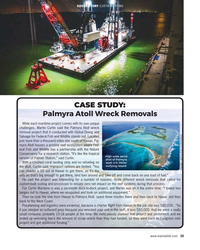 )
April 2023 - Maritime Reporter and Engineering News page: 35
)
April 2023 - Maritime Reporter and Engineering News page: 35. We meticulously planned that project and performed, and we ended up removing twice the amount of scrap wreck than they had funded, so they went back to Congress mid- project and got additional funding.” www.marinelink.com 35 MR #4 (34-44).indd 35 4/5/2023 6:58:41 P
-
 )
April 2023 - Maritime Reporter and Engineering News page: 24
)
April 2023 - Maritime Reporter and Engineering News page: 24to help us do the facility design and making by the end of the year. facility installation reviews moving forward. As offshore wind ramps up and Congress has provided us personnel to Staying on that safety note, can you describe BSEE’s do the work, we’re in the process of a huge hiring phase, process
